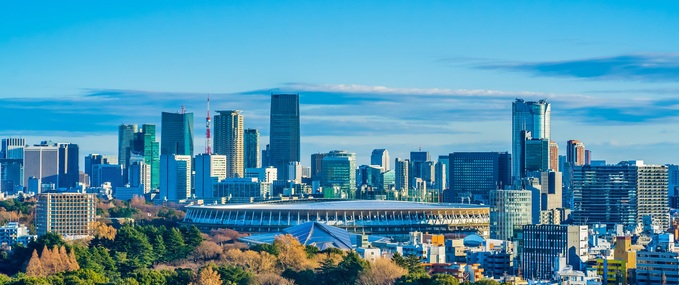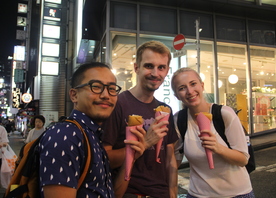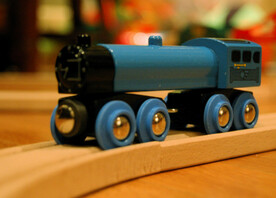The Tokyo 2020 Olympics and Paralympics were exhilarating, emotional end something to admire from a distance. As the world opens up and Japan once again opens for travel, it will become possible to see the Olympic sights in person. Here is our selection of the best Tokyo 2020 Olympics sights to visit, not just in Tokyo!
Table of contents:
Enoshima Yacht Harbour

Initially built for the Tokyo 1964 Olympics, the Enoshima Yacht Harbour was host to the sailing competitions. The yacht harbour was the first in Japan able to host sailing competitions and will continue doing so after the games. Located south of Tokyo and Yokohama, and overlooking the Sagami bay, the Enoshima harbour is a scenic spot with some of the finest beaches of Japan. Combine a visit to Enoshima with the other attractions in the area and close by Kamakura for an amazing day trip.
How to get there:
Getting to Enoshima from Tokyo is fairly easy, direct trains run to JR Fujisawa station (covered by the Japan Rail Pass), from there use a local tram or bus to access Enoshima.
Yokohama Baseball Stadium

A real landmark in the Yokohama skyline, the Baseball stadium is an impressive sight and home to the local Yokohama DeNA BayStars baseball team, and was primarily used for the baseball games during the Olympics. We highly recommend attending a match if you get the chance, the atmosphere is amazing, regardless of what team you’re cheering for. The stadium is within walking distance of other attractions in Yokohama, like the waterfront and seaside park, then combine it with a visit to the local China town for a good day of fun.
How to get there:
Yokohama stadium is within 10-15minutes walk from JR Kannai station, which is served by the JR Negishi Line. Coming from Tokyo, the easiest way is to take a direct train to Yokohama station, then use the Negishi Line to Kannai. The route is fully covered by the Japan Rail Pass.
J-Village National Training Center (Fukushima)
The symbol of Fukushima’s recovery efforts and the grand start of the Torch Relay. Previously, the J-Village served as the training ground for the Japanese national soccer teams. After the Fukushima disaster, it became the base of operations to keep things under control. Now, once more, the space has returned to a national soccer training facility that tells the story of the hardships endured following the disaster. The J-Village is an experience of hope and future dreams. After visiting, follow the route of the torch relay for more points of interest in the area.
How to get there:
The J-Village is within 5 minutes on foot from the nearby JR “J-Village” station and served by the JR Joban line that runs all the way out of Tokyo. For the sake of time, it is recommended to take a Ltd. Express train from Tokyo station to Iwaki (Fukushima) station and from there a local train on to J-Village.
Japan National Stadium

Many words have been written about the new Japan National Stadium in Tokyo, from problems during its construction to the much higher than anticipated building costs, the stadium was built on the spot of the old National Stadium to be the centre stage for the Olympics where both the opening and closing ceremonies were held. The stadium is a state-of-art design with huge sections build of modular wooden parts, so it is both sustainable and easily maintainable in the future. After the 2020 Games, the stadium will remain in use for sporting and cultural events. Located near Harajuku and Yoyogi park, the Japan National Stadium is an easy visit from anywhere in Tokyo.
How to get there:
Both the JR stations of Shinanomachi and Sendagaya are just minutes away on foot, and are served by the JR Sobu line. Alternatively it is about 20 minutes walk from JR Harajuku station on the JR Yamanote line.
Nippon Budokan

Built in 1964, Nippon Budokan, or just Budokan is the centre of martial arts in Japan, and host to many contests. More recently, the Budokan has also become a popular spot for musical performances, hosting many famous singers including ABBA, Queen and X Japan (just to name a few). A visit is a true look into the world of Japanese martial arts and tradition, whether it is to see a match or learn about its history. Located in the heart of Tokyo, it is an easy visit and can be combined with a visit to the Imperial Palace Garden, and Tokyo science museum.
How to get there:
The closest JR Station is JR Ichigaya station, which is about 20minutes away on foot from the Budokan, or 30 minutes away from Tokyo station on foot. Alternatively the metro station of Kudanshita is less than 5 minutes away on foot.
The Olympic and Paralympic Athletes' Village

Constructed in the Harumi waterfront district of Tokyo to accommodate the athletes from both the Olympic and Paralympic games. After the games are done, the village will be turned into a residential area to build a diverse community of people and ideas. With a total 5,650 residential units, it will be one of Tokyo’s most modern living quarters and symbol of how to build an Olympic village that will be beneficial for a long time to come. The village provides some of the best views of the Rainbow Bridge and Tokyo Bay.
How to get there:
While there is no JR station close by, the area can be accessed using the Tokyo Metro Oedo line. Get out at Kachidoki Station, from where it is about 10 minutes on foot.
Tsurigasaki Surfing Beach

World-class waves and prime beaches, Tsurigasaki has been a long time favourite for surfers. The 2020 Tokyo Olympics is the first time that surfing as a sport makes an appearance in the games, and Tsurigasaki was the first town ever to host surfing competition. The beach itself is great for water fun during summer, with different other beaches closely, including the famous Ichinomiya beach. Tsurigasaki is located within the peninsula of Chiba, home to many highlights and interesting outdoor activities like hiking and visiting the Big Buddha at Nokogiri-yama.
How to get there:
The closest JR Station is Torami station on the JR Sotobo line. A limited number of trains run here directly from Tokyo, else take a train to Chiba station first and then a train on the Torami.
Sapporo and Ohori park

Host to the race walking and marathon events of the Tokyo Olympics, Sapporo seems like an unlikely choice due to its location in the north of Japan. Still, the city has the capacity for the games, as it earlier hosted the Winter Olympics in 1972. The park is centrally located within the city and host to a variety of events and festivals throughout the year, including the well-known Sapporo Snow festival. Visit Sapporo and use it as your base to explore Hokkaido, using your JR Pass is one of the ways to get super value out of your pass. As the route is entirely covered, including the hyper fast Hayabusa Shinkansen between Tokyo and Hokkaido, the fastest train in Japan!
How to get there:
Take the Hayabusa Shinkansen from Tokyo to Shin-Hakodate-Hokuto, then transfer to a ltd. express train to Sapporo. A return ticket Tokyo - Sapporo is over 55.000yen, that’s more than the price of a 7-day or even 14-day JR Pass, talk about good value!

.png)
.jpg)


